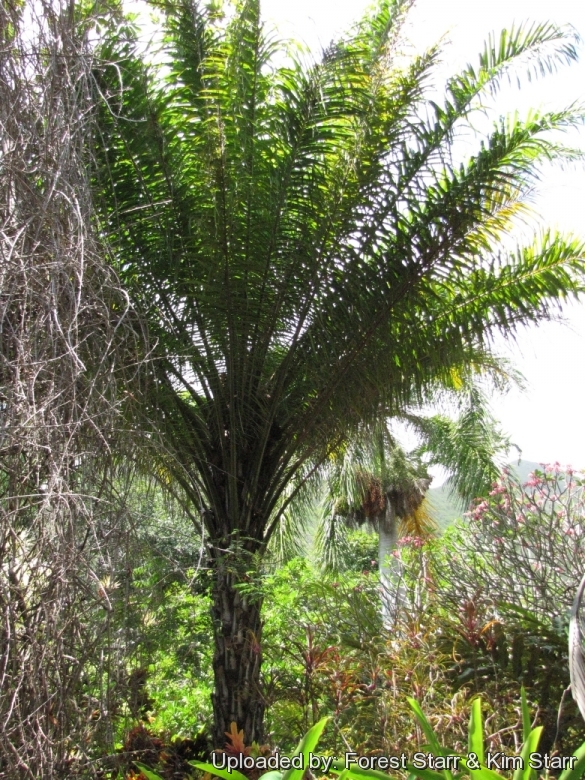
Elaeis guineensis Photo by: Forest Starr & Kim Starr
Origin and Habitat: West Africa (Liberia, Angola, Cameroon, Cote d'Ivoire, Democratic Republic of Congo, Ghana, Guinea, Sierra Leone, Uganda) Distinct populations are also found in Madagascar. Now introduced and cultivated throughout the tropics between 16°North and 16°South latitudes (China, Colombia, Congo, Costa Rica, Ecuador, Honduras, India, Indonesia, Kenya, Madagascar, Malaysia, Nigeria, Papua New Guinea, Philippines, Singapore, Solomon Islands, Sri Lanka, Tanzania, Togo, Venezuela, Zanzibar) Sometimes grown as an ornamental.
Altitude: Up to 900 m above sea level.
Habitat: It grows wild in coastal areas in savannah to rain forest or in freshwater swamps, with 2-4 month dry period. Mean annual temperature: 27-35° C, Mean annual rainfall: 2000-3000 mm. Cultivated for oil from the fruits. May escape cultivation and naturalize.
Synonyms:
See all synonyms of Elaeis guineensis
back
Accepted name in llifle Database:Elaeis guineensis Jacq.Select. Stirp. Amer. Hist. 280 (1763)Synonymy: 38
back
Common Names include:
ENGLISH: Wild oil palm, Guinea oil palm, Palm kernel oil, Oil palm, Macaw fat, African oil palm
ARABIC ( لعربية ): نخيل الزيت
BASQUE (Euskara): Afrikar olio palmondo
BURMESE: Si ohn, Si htan
CATALAN (Català): Palmera d'oli de Guinea
CREOLE: Crocro, Crocro guinee
CZECH (Čeština): Palma olejná
DANISH (Dansk): Oliepalme
DUTCH (Nederlands): Oliepalm
FINNISH (Suomi): Öljypalmu
FRENCH (Français): Crocro, Corossier, Corojo de Guinea, Palmier à huile d'Afrique, Palmier à huile, Huile de palme, Vin de palme., Crocro guinée
GERMAN (Deutsch): Steinfrüchte, Ölpalme, Afrikanische Ölpalme
GREEK (Ελληνικά): Ααβόρα, Ελαΐς της Γουινέας
HUNGARIAN (Magyar): Afrikai olajpálma, Olajpálma
ITALIAN (Italiano): Palma avoira, Palma da olio, Palma oleaginosa africana
JAPANESE (日本語): Opiriyasi
LITHUANIAN (Lietuvių): Gvinėjinė alyvpalmė
LUGANDA: Munazi, Mubira
MALAY (بهاس ملاي /Bahasa Melayu ): Kelapa sawit Bali, Kelapa sawit
MANDINKA or MANDING ((Mandi\'nka kango لغة مندنكا): Tengo, Tego, Tee, Tango
MAORI (Māori): Nū tāmara (Cook Islands)
NORWEGIAN (Bokmål): Oljepalme
PERSIAN (فارسی): نخل روغنی
POHNPEIAN: Nihn ahprika
POLISH ( Polski): Olejowiec gwinejski
PORTUGUESE (Português): Dendenzeiro, Caiaué (Brazil), Palmera dendém, Palmeira-de-óleo-africana, Aabora, Aavora, Palma-de-guiné, Palma, Dendém, Coqueiro-de-dendê
SPANISH (Español): Corojo de Guinea, Palma africana, Palma oleaginosa africana, Palmera de aceite, Palma africana de aceite, Palma aceitera, Coroco, Corozo
SWAHILI ( Kiswahili): Mchikichi, Miwesi, Mjenga
SWEDISH (Svenska): Oljepalm
THAI (ภาษาไทย): Pan namman
UPPER SORBIAN (Hornjoserbsce): Afriska wolijowa palma
VIETNAMESE (Tiếng Việt): Co dâu, Dua dâu
Description: Elaeis guineensis is a handsome palm-tree reaching a height of 20 m or more at maturity, with irregularly spaced leaflets and produces large bunches of dark red fruit. It is the principal source of palm oil and also the highest yielding oil-bearing crop.
Trunk: Stout, solitary, erect, sometimes bulging near the middle, 8-20 m tall, up to 30 cm in diameter, covered by the spirally arranged persistent woody, somewhat triangular leaf-bases above, bare below, dark grey-brown and ringed.
Root: Root system fibrous, consists of primary and secondary roots concentrated in the top 140 cm of soil.
Crown: Dense with 20-40 massive leaves.
Leaves: Large, pinnate, reduplicate, erect, spreading to drooping; rachid graceful, arched 3-3,5 m long with 100-150 leaflets in each side, the lower as spines on the petiole margin; Leaflets many, drooping, linear, green ,with prominent midribs, tapered to a point, irregularly divergent, singly along the rachis or somewhat fascicled in whorl of 4 or 5 or arising sometimes in different planes, about 60-120 cm long, 3.5-5 cm broad; petioles, fibrous, green, 1,3-2,3 m long; leaf-bases broad firmly adhering to the trunk,
Inflorescence: Banched to one order, with spinose tipped branches borne close to the trunk from lower leaf-axils. Monoecious, male and female flowers in separate clusters on the same tree, at different times (males usually first), but occasionally a single inforescence contains both male and female flowers; male flowers single or in pairs on short furry branches 10-15 cm long, set close to trunk on short pedicels; female flowers small, very numerous cream to white in large headlike clusters about 10-30 cm long and broad, enclosed in the bud stage in 2 large fibrous bracts, which finally become deciduous.
Fruits: Plum-like, ovoid-oblong, sessile, drupes, with pointed apex about 3,5-4 cm long and about 2 cm wide in bunches of 200-300 (but sometime up to 2000) close to trunk on short heavy pedicels, yellow to orange or nearly black when ripe, red at base, with thick ivory-white flesh and small cavity in center; nuts encased in a fibrous covering (a.k.a. kernel) which contains the palm oil. About 5 fruit clusters are produced per year; each weighing 8-23 kg (occasionally up to 80 or more kg), the fruits weighing about 3,5 g each.
Remarks: It may be confused with Elaeis oleifera, the American Oil Palm, but this species is shorter, has a more creeping than upright stem, and leaflets that are regularly arranged and spread in the same plane.
Bibliography: Major references and further lectures
1) Forest & Kim Starr Elaeis guineensis (African oil palm). Plants of Hawaii. <http://www.starrenvironmental.com>. Downloaded on 21 August 2014.
2) Burkill, H.M. "The useful plants of west tropical Africa", Vol 4 1985.
3) John Hutchinson, Frank Nigel Hepper, John McEwen Dalziel, Ronald W. Keay “Flora of West Tropical Africa” Volumi 2-3 Crown Agents for Aversea Governments and Administration, 1972
4) "Elaeis guineensis" in: Nancy R. Morin “Flora of North America: Volume 22: Magnoliophyta: Alismatidae, Arecidae, Commelinidae (in part), and Zingiberidae” Flora of North America Editorial Committee,, OUP USA, 20/Apr/2000
5) Dennis Victor Johnson “Palms: Their Conservation and Sustained Utilization : Status Survey and Conservation Action Plan” IUCN, 1996
6) Dransfield, J. and Beentje, H.J. 1995. Palms of Madagascar. Royal Botanic Garden, Kew.
7) Johnson, D. et al. 1997. Completed data collection forms for palms
8) Oldfield, S., Lusty, C. and MacKinven, A. (compilers). 1998. The World List of Threatened Trees. World Conservation Press, Cambridge, UK.
9) D. Louppe, A.A. Oteng-Amoako, M. Brink - 2008 Timbers 1: Volume 1;Volume 7 - Page 227
10) Don Ellison, Anthony Ellison “Cultivated Palms Of The World” UNSW Press, 01/May/2001
11) Robert Lee Riffle, Paul Craft “An Encyclopedia of Cultivated Palms” Timber Press, Portland 2007
12) Palmpedia contributors. "Elaeis guineensis ." Palmpedia, PALM ENCYCLOPEDIA, <http://www.palmpedia.net> Downloaded on 26 Aug. 2014
13) Jones, D. L. “Palms throughout the world.” 1994
14) Floridata contributors. "Elaeis guineensis." Floridata, <http://www.floridata.com> Accessed on 26 Aug. 2014
15) "Elaeis guineensis." PACSOA Palms and Cycads wiki , <http://www.pacsoa.org.au> Accessed on 26 Aug. 2014
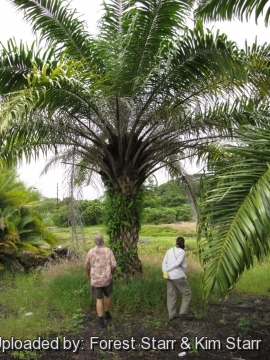 Habit with Bill and Kim at UH Hilo, Hawaii. July 16, 2012. Photo by: Forest Starr & Kim Starr
Habit with Bill and Kim at UH Hilo, Hawaii. July 16, 2012. Photo by: Forest Starr & Kim Starr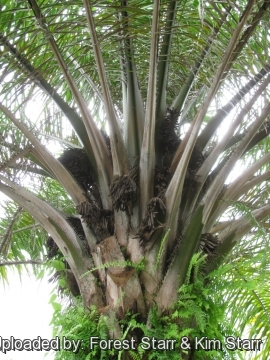 Crown with flowers at UH Hilo, Hawaii. July 16, 2012. Photo by: Forest Starr & Kim Starr
Crown with flowers at UH Hilo, Hawaii. July 16, 2012. Photo by: Forest Starr & Kim Starr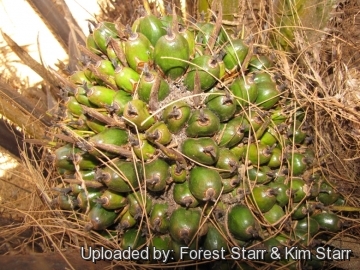 Green fruit at USDA Plant Materials Center, Molokai, Hawaii (USA). July 02, 2012. Photo by: Forest Starr & Kim Starr
Green fruit at USDA Plant Materials Center, Molokai, Hawaii (USA). July 02, 2012. Photo by: Forest Starr & Kim Starr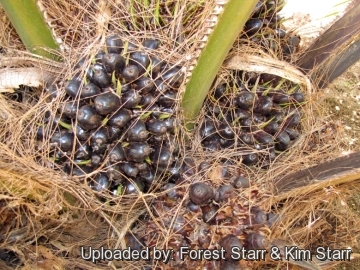 Fruit at USDA Plant Materials Center, Molokai, Hawaii (USA). July 02, 2012. Photo by: Forest Starr & Kim Starr
Fruit at USDA Plant Materials Center, Molokai, Hawaii (USA). July 02, 2012. Photo by: Forest Starr & Kim Starr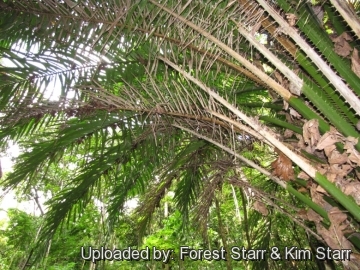 Fronds and armed stems at Keanae Arboretum, Maui, Hawaii (USA). February 16, 2012. Photo by: Forest Starr & Kim Starr
Fronds and armed stems at Keanae Arboretum, Maui, Hawaii (USA). February 16, 2012. Photo by: Forest Starr & Kim Starr Flowers and fruit at USDA Plant Materials Center, Molokai, Hawaii (USA). July 02, 2012. Photo by: Forest Starr & Kim Starr
Flowers and fruit at USDA Plant Materials Center, Molokai, Hawaii (USA). July 02, 2012. Photo by: Forest Starr & Kim Starr Thorns on stems at USDA Plant Materials Center, Molokai, Hawaii (USA). July 02, 2012. Photo by: Forest Starr & Kim Starr
Thorns on stems at USDA Plant Materials Center, Molokai, Hawaii (USA). July 02, 2012. Photo by: Forest Starr & Kim Starr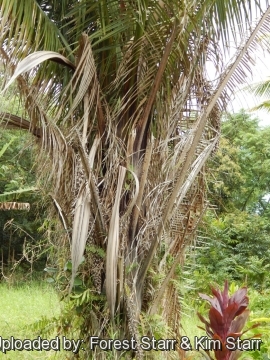 Habit at Hana Hwy, Maui, Hawaii (USA). February 22, 2014. Photo by: Forest Starr & Kim Starr
Habit at Hana Hwy, Maui, Hawaii (USA). February 22, 2014. Photo by: Forest Starr & Kim StarrCultivation and Propagation: This is an excellent palm adapt to tropical and subtropical climates, that does well in cultivation. It is little slow to take off but once established will grow quite fast.
Soil requirements: It has a fibrous root system and benefits from deep soils that are fertile, free from iron concretions and well drained and thrives on wide range of tropical soils, like coastal marine alluvial clays, soils of volcanic origin, acid sands and other coastal alluviums. It also tolerates a fair range of soil pH (4-8), although neutral soils are favourable. Waterlogged, highly lateritic, extremely sandy, stony or peaty soils should be avoided.
Watering: It prefers adequate moisture, can tolerate temporary flooding or a fluctuating water table, as might be found along rivers. This palm a will tolerate occasional dryness if not prolonged.
Light: It adapts well to full sun or half sun. If home-grown, give some sun as with most tropical palms.
Fertilization: Need a perfect fertilizer diet including all micro nutrients and trace elements. It is subject to potassium deficiency
Aerosol salt tolerance: It is moderately salt tolerant, but does a lot better inland then it does on the coast.
Hardiness: It is suited for tropical or subtropical climate and is slightly hardier than coconut but seedling growth arrested below 15°C. They do not bear temperatures even if just close to 0 °C. Mean maximum temperature of 30-32°C and mean minimum of 21-24°C (USDA Zones 11-12) as
Wind hardiness: It can tolerate sweltering heat and moderately windy conditions.
Propagation: The seeds germinate easily when fresh (in 6-8 months) if opportunely previously treated and and with bottom heat. If not properly treated, the seed does not have long shelf life.
Oil production:: Palm yields two kinds of oil: the palm oil and palm-kernel oil. Palm oil chiefly used in the manufacture of soaps and candles. The palm-kernel oil is used for making vegetable butter. For every 100 kg of fruit bunches, 22 kg of palm oil and 1.6 kg of palm kernel oil can be extracted.
Traditional medicine: In Guinea, oil is applied to wounds as a vulnerary and as a liniment for rheumatism and courbature. Elsewhere, poultice made from oil used for wounds. In Equatorial West African, roots used as diuretic and fresh sap as laxative. In South Eastern Nigeria, used for treatment of various diseases and skin infections.
Beverage use: In Africa a kind of wine is made from the trees.

















